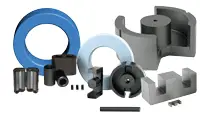
Ferrites are ceramic, homogeneous materials composed of various oxides with iron oxide as their main constituent.
Based upon chemical composition, soft ferrites are divided into: manganese-zinc ferrite and nickel-zinc ferrite. In each category many different MnZn and NiZn material grades can be manufactured by changing the chemical composition or manufacturing technology.
Manganese-Zinc Ferrites: This type is the most common and used in many more applications than the nickel-zinc ferrites. Within the MnZn category a large variety of materials is possible. The material selection is mainly a function of the application that needs to be accommodated. Manganese-zinc ferrite is primarily used for frequencies less than 2 MHz.
Nickel-Zinc Ferrites: This class is characterized by its high material resistivity, several orders of magnitude higher than MnZn ferrites. NiZn ferrite is the material of choice for operating from l-2 MHz to several hundred megahertz. To cover such a wide frequency range and different applications, a large number of nickel-zinc materials have been developed over the years. Certain nickel chemistries, especially those containing cobalt, can be adversely changed by some types of stress such as mechanical shocks from dropping or from some grinding operations. Resulting changes can include increasing of permeability and core loss (lowering of Q). These changes cannot be reversed but in some cases, a thermal anneal at high temperature can restore some of the initial properties.
Core Geometries: Core geometries can be tailored to meet specific magnetic and mechanical requirements. A tunable high Q inductor dictates a different core shape than one used in TV line output transformers.
Shop our large online selection of ferrite cores in our online store or contact us with your specific request.

